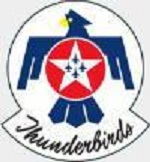Hobby Master HA2502 USAF Republic F-105B Thunderchief Fighter-Bomber - Thunderbirds, 1964 (1:72 Scale)
"Tell the Vietnamese they've got to draw in their horns or we're going to bomb them back into the Stone Age. And we would shove them back into the Stone Age with Air power or Naval power - not with ground forces."
- General Curtis LeMay, May 1964
 The Republic F-105 Thunderchief was a supersonic fighter-bomber used by the United States Air Force. The Mach 2 capable F-105 bore the brunt of strike bombing over North Vietnam during the early years of the Vietnam War. Originally designed and deployed as a single seat aircraft, a two-seat Wild Weasel version was later developed for use in the specialized Suppression of Enemy Air Defenses (SEAD) role against surface-to-air missile sites. It was commonly known as the Thud by its crews.
The Republic F-105 Thunderchief was a supersonic fighter-bomber used by the United States Air Force. The Mach 2 capable F-105 bore the brunt of strike bombing over North Vietnam during the early years of the Vietnam War. Originally designed and deployed as a single seat aircraft, a two-seat Wild Weasel version was later developed for use in the specialized Suppression of Enemy Air Defenses (SEAD) role against surface-to-air missile sites. It was commonly known as the Thud by its crews.
As a follow-on to the Mach 1 capable F-100, the F-105 was also armed with missiles and a cannon; however, its design was tailored to high-speed low-altitude penetration carrying a single nuclear bomb internally. First flown in 1955, the Thunderchief entered service in 1958. As the largest single-engined fighter ever employed by the USAF, the single-seat F-105 would be adapted to deliver a greater iron bomb load than the four-engined, 10-man strategic bombers of World War II like the B-17, B-24 and B-29. The F-105 would be best remembered as the primary strike bomber over North Vietnam in the early stages of the Vietnam War. Over 20,000 Thunderchief sorties were flown, with 382 aircraft lost (nearly half of the 833 produced) including 62 operational casualties. Although it lacked the agility of the smaller MiG fighters, USAF F-105s demonstrated the effectiveness of guns, and were credited with downing 27.5 enemy aircraft.
During the war, the two-seat F-105F and F-105G Wild Weasel variants became the first dedicated Suppression of Enemy Air Defenses (SEAD) platforms, fighting against the Soviet-built S-75 Dvina / (SA-2 Guideline) surface-to-air missiles. Two Wild Weasel pilots were awarded the Medal of Honor for attacking North Vietnamese surface-to-air missile sites, with one shooting down two MiG-17s the same day. The dangerous missions often required them to be the "first in, last out," suppressing enemy air defenses and keeping them suppressed while strike aircraft accomplished their missions and then left the area.
Although the F-105 weighed 50,000 pounds (22,680 kg), the aircraft could exceed the speed of sound at sea level and Mach 2 at high altitude. It could carry up to 14,000 pounds (6,700 kg) of bombs and missiles. The Thunderchief was later replaced as a strike aircraft over North Vietnam by both the F-4 Phantom II and the swing-wing F-111. However, the "Wild Weasel" variants remained in service until 1984, when they were replaced by a specialized F-4G "Wild Weasel V". The USAF F-4G was subsequently replaced by the USAF F-16CJ Fighting Falcon aircraft, currently employed in the SEAD role.
Pictured here is a 1:72 scale rendition of a F-105B Thunderchief fighter-bomber that was flown by the USAF Thunderbirds aerobatic team during 1964.
Sold Out!
Dimensions:
Wingspan: 6-1/4-inches
Length: 10-1/2-inches
 Historical Account: "Thunderbird Heaven" - The Thunderbirds are the Air Demonstration Squadron of the United States Air Force. As such, they tour the United States and much of the world, performing aerobatic formation and solo flying in specially-marked USAF jet aircraft.
Historical Account: "Thunderbird Heaven" - The Thunderbirds are the Air Demonstration Squadron of the United States Air Force. As such, they tour the United States and much of the world, performing aerobatic formation and solo flying in specially-marked USAF jet aircraft.
Officers serve a two-year assignment with the squadron, while enlisted personnel serve three to four. Replacements must be trained for about half of the team each year, providing a constant mix of experience.
The squadron performs no more than 88 air demonstrations each year and has never canceled a demonstration due to maintenance difficulty.
In addition to their air demonstration responsibilities, the Thunderbirds are part of the USAF combat force and a component of the 57th Wing. If required, the team's personnel and aircraft can be rapidly integrated into a fighter unit at Nellis Air Force Base, Nevada.


